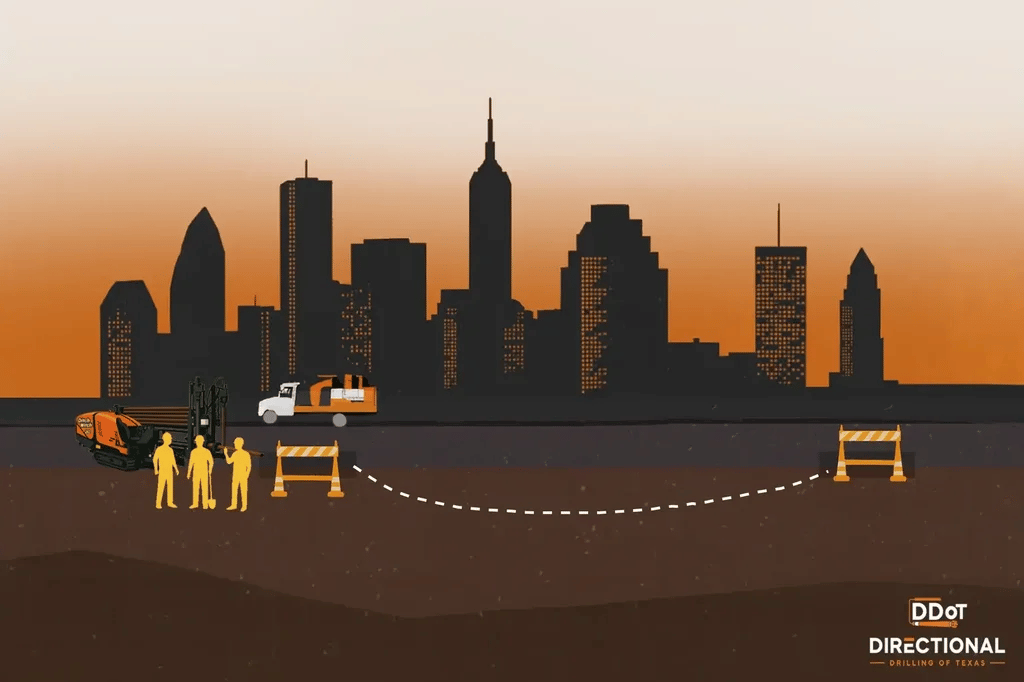Frequently Asked Questions About Horizontal Directional Drilling

1. What is Horizontal Directional Drilling?
Horizontal Directional Drilling (HDD) is a trenchless method for installing underground pipes, conduits, and cables using a surface-based drilling rig. The process involves hydraulically and
mechanically removing material from the hole with a drill pipe and a bottom hole assembly
(BHA), which includes a drill bit, mud motor, and steering tool. A pilot hole is drilled along a
predetermined path using a surface coil or walk-over steering system. The hole’s diameter is
then expanded with a reamer (or hole opener) to accommodate the utility line.
At present, we can drill a pilot hole of 2 inches and expand it to 4 inches with a reamer.
2. What are the Minimum and Maximum Diameters You Can Drill?
Our current capacity is to drill a pilot hole of 2 inches and expand it to a diameter of up to 4 inches.
3. What are the Minimum and Maximum Lengths of Crossing?
The maximum length and hole diameter depend on the project's geotechnical conditions. Heavy rigs can handle crossings of up to 3,000 meters (9,843 feet). Light rigs are ideal for crossings between 50 and 1,000 meters (164 to 3,281 feet).
4. What Size of Pad is Required for Rigs?
A typical light rig setup requires a workspace footprint of approximately 10 meters wide by 30 meters long (33 feet x 98 feet). This includes space for the drilling rig, support truck, drill stem trailer, and water truck. This size does not account for spoils disposal. As a practical matter most other equipment such as trucks and trailers can be parked in a street or in another area while the drill work is being performed.
5. What is Your Production Rate?
Production rates vary depending on the geological formation and the size of the product line. A light rig can typically drill up to 400 meters in a 12-hour shift. If the underlying terrain consists of rock, the drilling will take longer.
6. What Types of Pipes/Lines Can Be Installed?
HDD is suitable for installing fiber optic cables, TV cables, water and sewage mains, electrical lines, and some types of gas pipelines.
7. Do Light Rigs Operate 24-hour Shifts?
8. How Accurate are the Steering Tools?
Light rigs use two types of steering systems: "walkover" and "wireline," both of which offer extremely high accuracy for navigating underground paths.
9. How Long Does it Take to Set Up a Light Rig?
With proper access for large trucks, a light rig can be set up and ready to drill within an hour.
10. What Information is Required Before Starting an HDD Project?
The following information is typically needed:
● Stamped trenchless design blueprints
● Geotechnical investigation findings
● A Request for Proposal (if applicable)
● An 811 Timely Notice before drill work begins
11. What Challenges Can HDD Overcome?
HDD is ideal for installing pipes or utility lines in what would otherwise be challenging situations, including:
● Under environmentally sensitive areas (rivers, lakes, wildlife habitats)
● Beneath roads, freeways, intersections, parks, railroads and golf courses
● Across existing utility corridors or into facilities
● In marine environments (e.g., desalination plants)
● In residential or crowded urban areas.
12. What On-Site Disposal is Needed?
The drilling process uses bentonite, a naturally occurring substance derived from volcanic ash. On smaller projects, we handle disposal during drilling. For larger projects, on-site disposal plans may be necessary for the larger volumes of bentonite and drill cuttings.
13. Why Choose Directional Drilling Over Open Cutting (Trenching)?
HDD offers numerous advantages over traditional trenching methods:
● Quick setup and minimal labor requirements
● Reduced surface disruption, preserving urban and natural landscapes
● Lower restoration costs for roads and infrastructure
● Minimal earth removal and reduced long-term settlement risks HDD is particularly beneficial in urban areas where it is considered the preferred technology for underground installations.
● Less Environmental Disruption
● Less noise
14. What is 811 and Why Is It Important?
811 is the national “Call-Before-You-Dig” phone number. Anyone planning to dig should call 811 or go to their state 811 center’s website as early as possible but at least a few business days before digging work begins. When you call you will provide the area where you will be digging and request that the approximate location of buried utilities be marked with paint or flags. The 811 number is valid in all fifty (50) states. You do not want to unintentionally hit an underground utility and the 811 service helps to prevent that from happening. To know the 811 law and process in your state, click here: https://call811.com/811-In-Your-State.
15. How do HDD Workers Hear Their Communications Between Them?
The ambient noise of the drilling operation can interfere with communication between workers. It is imperative that the locator and operator be able to communicate clearly and concisely while drilling is being conducted. This provides for safety and accuracy.
The best products on the market include headsets that have noise cancelling and do not require a push-to-talk requirement. DDoT utilizes a Sonetics SONPW3 (Sonetics Portable Wireless System) for streamlined quality communication among the drilling crew.
16. What are the Main Companies that Manufacture Directional Drill Machines?
- Ditch Witch
- Vermeer
17. What other Equipment is Necessary to Have in Addition to the Directional Drill?
- Locator and Drill Beacon.
- At least two heavy duty pick-up trucks
- At least two heavy duty trailers
- An excavator
- A water tank (500 gallon minimum)
- Directional Drill Safety Equipment and Clothing
- Shovels
- A utilities locator (not necessary but very helpful)
- Many other miscellaneous items
18. What are the normal insurance coverage amounts for horizontal drilling?
Usually at least $5,000,000.00 in liability coverage limits
We hope the above addresses most if not all the questions you may have about Horizontal Drilling but if you have other matters you wish to clarify please use our contact form to reach us.
